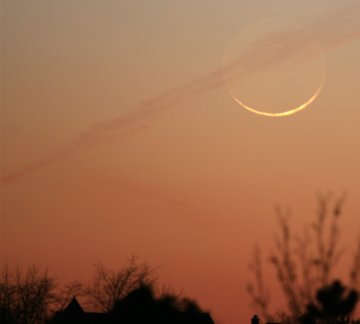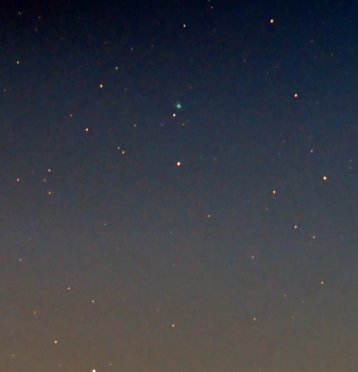 Did you miss last night's auroras? Next time get a wake-up call from Spaceweather PHONE.
Did you miss last night's auroras? Next time get a wake-up call from Spaceweather PHONE.
ASTEROID 2007 HA: Newly discovered asteroid 2007 HA is flying past Earth today about 2.5 million kilometers away. It's big (300 meters wide), bright (13th magnitude), and an easy target for large backyard telescopes. Last night, Greg Selleck of Madison, Wisconsin, made this 75-minute movie (1.8 MB mpeg) of the space rock racing 47,000 mph through the constellation Virgo. Tonight the asteroid streaks across the Big Dipper. [ephemeris] [3D orbit]
CRESCENT MOON: Consider it a challenge. Go outside tonight at sunset and look west for the crescent Moon--a super-slender, exquisitely beautiful crescent less than one day past New. The scene will look something like this:

Photo details: Canon Rebel XT, Sigma 400mm lens, ISO 400, 3.2 sec
Mike Caplan of Wadsworth, Illinois, took the picture last month when the Moon was similarly slender. It's tricky to catch the Moon so thin, but worth the effort. Try it! (Observers west of the Rocky Mountains in the USA are favored, and even there binoculars may be required.)
COMET ENCKE: "Now is the time to observe Comet 2P/Encke!" says Tony Cook of Devon, UK. "The famous short period comet is currently shining like a 4th magnitude star in the western sky at sunset." He took this picture on April 9th; Encke is the green fuzzball at top-center:

Photo details: Canon 10D, Televue 85, ISO 800, 10 x 1 minutes
"Trace a line from Venus to where the sun has set and you will find Encke about halfway along this line," Cook advises. "The best way to observe Encke is with binoculars or a wide field telescope."
Comet Encke is plunging toward the sun and soon will be lost in the glare, so catch it while you can. [sky maps: April 17, April 18] [ephemeris] [3D orbit]

